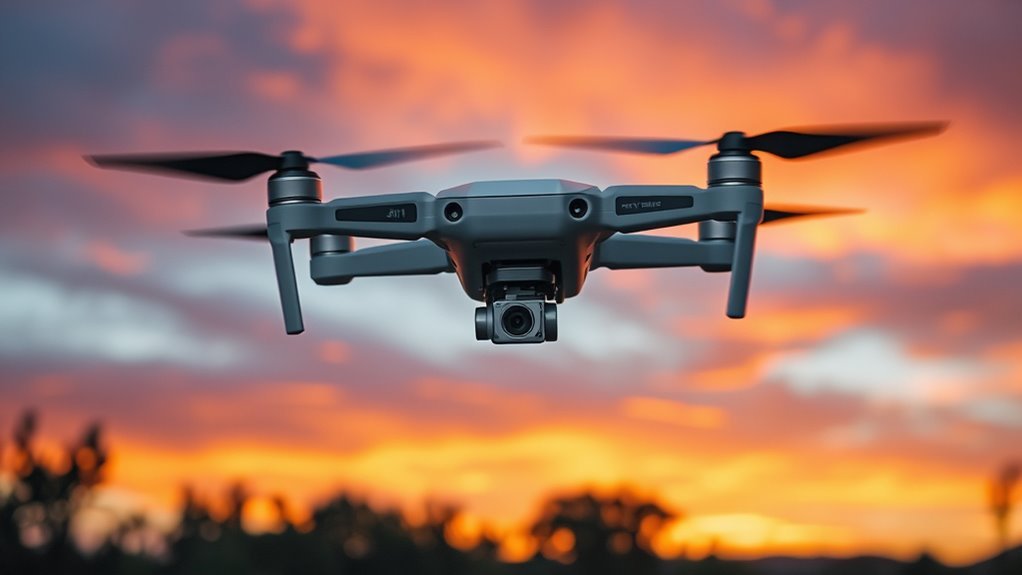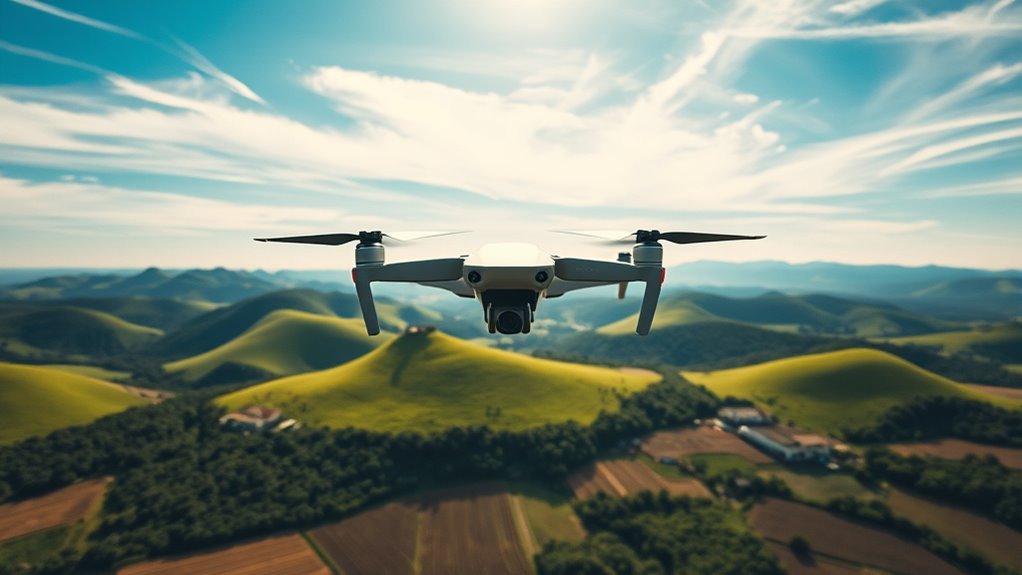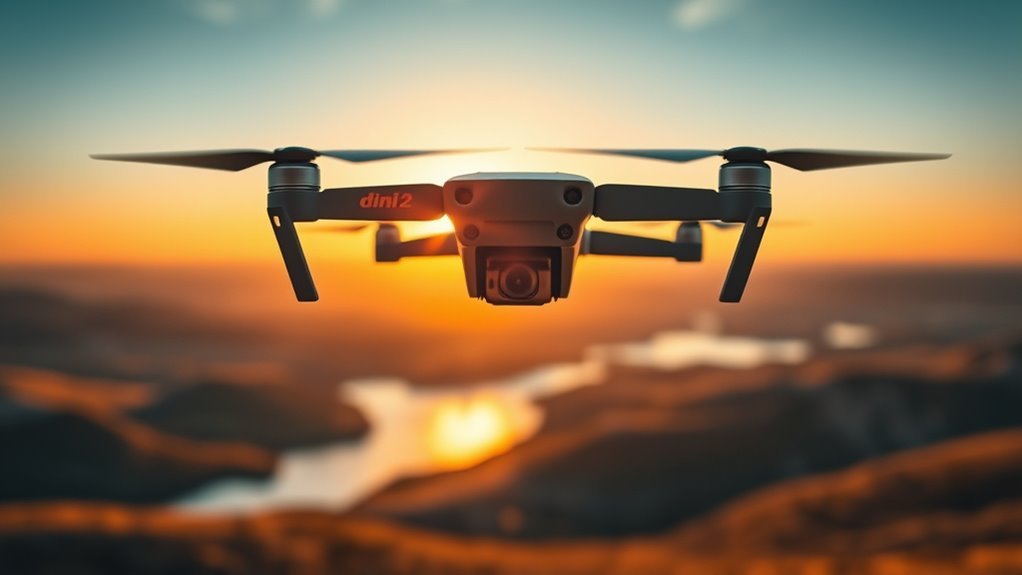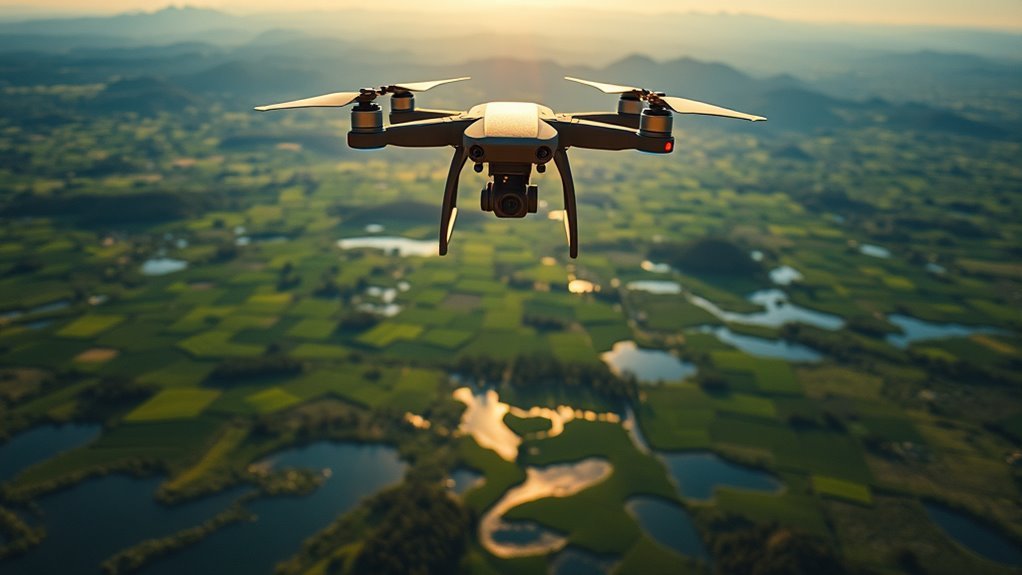If you’re looking for a compact drone, the DJI Mini 2 offers excellent 4K video with stable footage thanks to its three-axis gimbal. It’s lightweight at 249 grams, has strong wind resistance, and a solid 31-minute battery life. The intuitive controller and intelligent modes simplify flying, though it lacks obstacle avoidance, so caution is needed. Its build quality and portability are impressive for exploration. There’s more to explore about its features and performance.
Design and Build Quality

The design of the DJI Mini 2 reflects a careful balance between portability and durability, making it an ideal choice for both beginners and seasoned drone pilots. You’ll notice the ergonomic design that guarantees comfortable handling and easy control, even during extended flights. Its compact frame weighs just 249 grams, making it incredibly portable without compromising on sturdiness. The material durability is evident in the high-quality plastics reinforced with resilient components, allowing the drone to withstand minor impacts and adverse weather conditions. This thoughtful engineering offers you freedom to explore without worrying about frequent damage or cumbersome equipment. The foldable arms enhance transport convenience, while the robust build instills confidence, supporting your desire to capture adventurous moments wherever you go.
Camera Specifications and Image Quality

You’ll find the Mini 2’s 1/2.3-inch sensor captures 12MP stills with a maximum resolution of 4000×3000 pixels, balancing detail and file size effectively. Its ability to shoot 4K video at 30fps is complemented by a three-axis gimbal, which helps maintain smooth footage even in windy conditions. Evaluating how these specs translate into real-world image and video quality will be key to understanding its performance.
Sensor and Resolution
Image quality on the DJI Mini 2 is largely defined by its 1/2.3-inch CMOS sensor, which captures 12-megapixel stills and supports 4K video recording at 30 frames per second. This sensor technology balances compact size with effective light capture, directly influencing the resolution impact on your images and footage. While it won’t rival larger sensors, it provides impressive detail and color accuracy for its class, giving you the freedom to shoot crisp, high-resolution content.
| Feature | Specification | Impact on Quality |
|---|---|---|
| Sensor Size | 1/2.3-inch CMOS | Compact, good light sensitivity |
| Photo Resolution | 12 MP | Sharp still images |
| Video Resolution | 4K @ 30fps | Detailed, smooth footage |
| Sensor Technology | CMOS | Efficient image processing |
Video Stabilization Quality
Beyond sensor capabilities and resolution, video stabilization plays a significant role in guaranteeing smooth, professional-looking footage with the DJI Mini 2. This drone utilizes advanced gimbal technology, featuring a 3-axis mechanical gimbal that effectively counters unwanted movements and vibrations during flight. Combined with sophisticated stabilization algorithms, it minimizes jitter and motion blur, even in windy conditions or rapid maneuvers. For you, this means capturing crisp, steady video without relying heavily on post-processing. The integration of hardware and software stabilization offers reliable performance, enhancing the freedom to focus on creative framing rather than technical limitations. Whether you’re capturing sweeping landscapes or dynamic action shots, the DJI Mini 2’s video stabilization guarantees your footage stays fluid and immersive throughout your flight experience.
Flight Performance and Battery Life

Although compact in size, the DJI Mini 2 delivers impressive flight performance with stable handling and responsive controls, making it suitable for both beginners and experienced pilots. You’ll appreciate its flight stability, even in moderate wind resistance, allowing confident navigation and smooth footage capture. The battery life extends your freedom, providing up to 31 minutes of continuous flight per charge, which balances endurance with lightweight design.
Key flight and battery features include:
- Precise control and quick responsiveness for agile maneuvering
- Strong wind resistance up to level 5, guaranteeing steady flight
- Intelligent battery management optimizing power consumption
- Up to 31 minutes flight time per battery with fast recharge capability
This combination guarantees you can explore freely without frequent interruptions.
Intelligent Flight Modes
The DJI Mini 2’s reliable flight performance is complemented by a suite of intelligent flight modes designed to enhance your aerial photography and piloting experience. These modes employ intelligent navigation algorithms that allow the drone to execute complex maneuvers with minimal input from you, providing both safety and creative freedom. While the Mini 2 doesn’t feature advanced obstacle avoidance, its GPS-based positioning system guarantees stable hovering and precise returns to home. Automated filming modes such as QuickShots enable you to capture cinematic shots effortlessly, including dronies, circles, and helix patterns. This balance between user control and automation means you can focus on framing your shots rather than piloting difficulties. Ultimately, the intelligent flight modes empower you to explore creative possibilities without compromising ease of use or flight stability.
Remote Controller Features
A well-designed remote controller is essential for maximizing the DJI Mini 2’s functionality and flight precision. The remote control offers an ergonomic grip and intuitive user interface, ensuring you maintain full command and effortless navigation. Its features enhance your freedom to fly confidently and creatively.
Key aspects of the remote controller include:
- Compact design with detachable control sticks for easy storage
- Integrated smartphone holder for real-time video feed and telemetry
- Dedicated buttons for quick access to return-to-home and camera controls
- Extended transmission range supporting up to 10 km for unrestricted exploration
This remote control balances simplicity and sophistication, providing precise inputs that translate into smooth flight performance. The user interface is responsive and straightforward, allowing you to focus on capturing stunning aerial footage without distraction.
Portability and Ease of Transport
With just 249 grams, the DJI Mini 2 is designed to fit seamlessly into your lifestyle, making portability a key strength. Its compact design guarantees the drone folds down to a size that slips easily into backpacks or even large pockets, eliminating the burden of bulky gear. This ultra-lightweight structure not only meets strict weight regulations in many countries but also enhances travel convenience, letting you explore remote locations without added hassle. The included carrying case is thoughtfully sized, providing secure storage while maintaining minimal footprint. Whether you’re hiking, city touring, or venturing abroad, the Mini 2’s ease of transport means you’re always ready to capture stunning aerial footage without compromising on freedom or mobility.
Software and App Experience
Although flying the DJI Mini 2 is straightforward, getting the most out of it depends heavily on the companion app’s functionality and user interface. The app’s user interface design is intuitive, giving you quick access to essential controls without clutter. Its app functionality supports seamless firmware updates and real-time telemetry, vital for responsive flight adjustments. You’ll appreciate the streamlined layout that balances simplicity with powerful features, enabling freedom in creative control.
Key aspects include:
- Clear, minimalistic user interface design for ease of navigation
- Reliable real-time video feed with minimal latency
- Extensive flight data and customizable settings
- Integrated camera controls for adjusting photo and video parameters
This combination makes the software an indispensable extension of your flight experience.
Safety Features and Flight Restrictions
When flying the DJI Mini 2, you should know it lacks a dedicated obstacle avoidance system, which means you’ll need to rely more on your own vigilance to prevent collisions. However, the drone does include extensive no-fly zone compliance, automatically restricting flights in sensitive or regulated areas. Understanding these safety features and restrictions is vital to guarantee responsible and legal operation.
Obstacle Avoidance System
The obstacle avoidance system on the DJI Mini 2 is particularly absent, which directly impacts its safety features and flight restrictions. Unlike drones with advanced obstacle detection, the Mini 2 lacks sensors to autonomously detect and avoid obstacles. This limitation affects your flight freedom, requiring heightened vigilance and manual control to prevent collisions. While this absence reduces the complexity and weight of the drone, it also means fewer safety enhancements are integrated into its design. Here’s what you need to reflect on:
- No forward or downward obstacle sensors
- Reliance on pilot skill for collision prevention
- Greater caution needed in complex environments
- Flight restrictions depend more on user awareness than automated safeguards
If you want freedom in flying, be prepared to compensate for this gap with careful planning and attention.
No-Fly Zone Compliance
Understanding no-fly zone compliance is essential for anyone operating the DJI Mini 2, as it directly affects where and how you can legally and safely pilot the drone. DJI integrates up-to-date no fly regulations into its GEO system, restricting flights in sensitive areas. While these compliance requirements might feel limiting, they guarantee safety and legal operation, letting you focus on flying freely within allowed zones.
| Zone Type | Restriction Level | Example Locations |
|---|---|---|
| Restricted | Flight prohibited | Airports, military bases |
| Authorization | Requires permission | Stadiums, government sites |
| Warning | Flight caution advised | Urban centers, national parks |
Value for Money and Competitors Comparison
Although the Dji Mini 2 offers impressive features for its size, you’ll want to carefully weigh its price against what competitors provide in similar categories. Its pricing strategy balances advanced tech with portability, but your user experience depends on how much value you place on specific features. When comparing, consider:
- Battery life and flight time relative to cost
- Camera quality and stabilization capabilities
- Ease of use and software support
- Weight and portability constraints
Competitors like the Holy Stone HS720 and the Autel Robotics EVO Nano+ offer competitive alternatives, sometimes at lower prices but with trade-offs in camera specs or range. Ultimately, you should evaluate which drone aligns best with your freedom to explore and your priorities, ensuring you get the most value without compromising the experience you seek.

